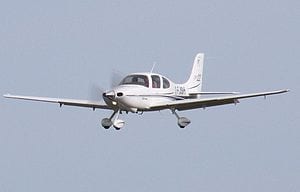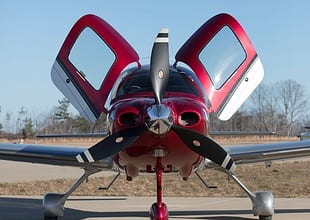Would you like to fly a well-maintained, newer airplane, but can’t afford to buy one just yet? Rather than back-burner this dream, you might want to consider fractional ownership.
One of the first fractional programs available to the single-engine piston driving crowd was PlaneSmart!, which began operations in 2003, “as a means to give pilots access to well-maintained, quality airplanes,” said Michael Brosler, president and CEO.
“Typically, when you wanted to rent an airplane in 2003, you saw lots of very old Cessnas on the ramp,” he said. “Although they may have been mechanically well-maintained, they often had oil on the belly and were a little rough looking. If you wanted to buy a new airplane, it was exceedingly expensive and it was very hard for most people to justify the cost.”
PlaneSmart!’s first planes were Cirrus aircraft.
“We chose the Cirrus platform because of its glass technology and because the airplane was well beyond everybody else when it came to safety features,” said Brosler, referring to the Cirrus Airframe Parachute System.
 The company buys the aircraft, then sells shares to its customers, starting at 1/4th share. Down payments range from $1,500 to $7,500 (depending on the aircraft model), with a monthly payment from $1,164 to $3,295. Clients can get up to 150 flight hours per year.
The company buys the aircraft, then sells shares to its customers, starting at 1/4th share. Down payments range from $1,500 to $7,500 (depending on the aircraft model), with a monthly payment from $1,164 to $3,295. Clients can get up to 150 flight hours per year.
PlaneSmart!’s Cirrus fleet ranges ranging from the SR20 to the turbo-equipped models. Panels run the gamut from legacy gauges to Avidyne and Garmin glass.
The company uses MyFBO, a computer-based scheduling software that helps keep track of aircraft usage as well as pilot qualification issues, such as a medical certificate expiration.
“Every client has a status update that shows currency, medical expiration, passport and the like,” said Brosler. “There is also a pre-dispatch sheet which shows all the things you normally check on the aircraft as part of the pre-flight inspection, such as annual inspection, and shows you when the inspection was last done and the number of hours until the next one.”
This way, says Brosler, a client who is planning a flight that will put the plane past a required inspection or maintenance can easily move into another aircraft.
“We have 27 airplanes. Getting access to one of them is not an issue,” he said.
PlaneSmart! does not require pilots to have a minimum experience level to become fractional owners.
“We are a Platinum Training Center for Cirrus. We do their standardization training and we can do everything from transition training from the six-pack legacy gauges to glass cockpit,” he said. “Cross-training is available for both Avidyne and Garmin panels. We can take the client from zero time up through their instrument ticket.”
Owners pay a monthly management fee that covers scheduling, maintenance, insurance, hangar, XM weather and GPS subscriptions, cleaning, Bose headsets, IFR/VFR charts, and more. There is a flight hour fee to cover the direct operating costs of the aircraft, such as fuel, oil and reserves. The owner can sell their share at fair market value of the underlying aircraft and exit the program, or apply the sales credit to a new PlaneSmart! aircraft.
In addition to giving pilots access to aircraft they might otherwise not be able to afford, Brosler sees the fractional market as a means for aircraft manufacturers to sell more airplanes.
“The market share of pilots who can afford an airplane all by themselves is perhaps 1%. The market share of pilots who can afford ¼ of an airplane is about 20%,” Brosler noted.
PlaneSmart!’s fleet also includes larger, faster airplanes such as the Piper Meridian, Piaggio or Pilatus for clients whose needs and mission change.
“Our customers are able to move into those airplanes,” Brosler explained.
The Cirrus is also the aircraft of choice for Ascension Air, located in Augusta, Ga., which launched its fractional ownership program in 2012. The company’s fleet of 2012-2013 Cirrus Turbocharged SR22T GTS airplanes are based in the Atlanta area, according to Jamail Larkins, president
 He quotes some numbers: “A 1/8 share is $96,825. With $19,365 down — a reduced down payment sales incentive available in some cities — monthly payments for a share purchase are $945, plus a monthly management fee of $1,225.”
He quotes some numbers: “A 1/8 share is $96,825. With $19,365 down — a reduced down payment sales incentive available in some cities — monthly payments for a share purchase are $945, plus a monthly management fee of $1,225.”
Clients must have their private pilot certificate and instrument rating and at least 200 hours as pilot in command. “There are some exceptions, based on individual pilot time in Cirrus or pilots actively working toward an instrument rating,” he noted. “Also, our insurance requirements require pilots flying in Ascension aircraft to complete an initial 90-day review, and then six-month ongoing recurrent training sessions. Individual pilot requirements regarding flight reviews, VFR, and IFR currency must also be maintained.”
According to Larkins, fractional ownership allows pilots to own higher quality and safer airplanes for nearly the same price as much older, technologically inferior ones.
“Our fractional ownership program allows pilots to own and enjoy shares of top-of-the-line aircraft for about the cost of sole ownership of a 1980s used Cessna,” he noted. “On average, pilots fly about 80 hours per year, which is exactly what our program offers owners of a 1/8 share, plus 15 hours per year for training and 15 more per year for charity flights.”
“Our program boasts 90% availability for only 12% of the cost of sole ownership,” he continued. “In reality sole ownership does not allow much more than 90% availability at all. Maintenance squawks, as well as lengthy scheduled maintenance stints, dramatically reduce availability.”
Scheduling is done by the Ascension Air Owner Services Team. “Owners can schedule time in their airplane 24 hours a day either by calling, emailing or using our custom mobile app available in the Apple App Store,” he said.
Larkins noted that although Ascension Aircraft does not permit primary flight instruction in the airplane, customers are welcome to do training to earn a higher license or rating. “Ascension does keep track of all required training as determined by our insurance underwriter. No owners are allowed to operate the airplane as PIC unless they meet the insurance requirements,” he said.
The professional management of items like insurance, maintenance and more, is critical. “Without professional management, it can lead to poorly maintained airplanes and confusion when it comes to the distribution of responsibility among owners,” he said. “Our program eliminates that pitfall of fractional ownership by professionally managing our fleet and keeping the aircraft in perfect condition.”
For more information: Planesmart.com, Ascensionaircraft.com

On average month I spend $400-600 on flying. I cannot afford (nor see any justification) to own so I rent what I can. Usually 20-40 year old sixpacks.
Now more than $2000 a month is just too expensive for a hobby. This does not even include flight time so for $24K a year one gets.. nothing. It is just beyond reach for most people.
Wow, $1,500 down and $1,164 a month to $19,00 down, $945 a month PLUS a $1,225 maintenance fee per month! It is no wonder that the non-flying public thinks we are all wealthy when these are the deals that make headlines. Please GA news, for the sake of those who may read the paper at a doctor’s office balance these articles with mention of $16,00 dollar T-crafts or $20,00 Cherokees. Please help get word out that many airplanes are the cost of cars not the cost of houses that many of us could not afford.
Greg – how true! GA’s biggest problem is they continue to “sell” (re-sell) to those who have ALREADY been sold! That said, however, no such cost effective media vehicle to date, with possible exception of the Internet, is available that would reach the non-flying public. Perhaps a co-op ad $$$ campaign sponsored by GAMA, AOPA, NBAA, etc in select markets would do the trick?